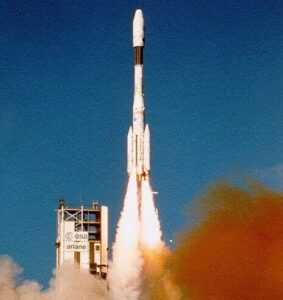The Growing Appeal of Missiles: Current Drivers behind Ballistic Missile Acquisition and Development
HCOC RESEARCH PAPERS NO. 14
In many regions, a number of countries are currently developing or acquiring ballistic missiles. The efforts to procure these systems are especially visible in the Middle East, in Asia and in Europe. Some of these programmes have been active for years. Some have been triggered by ongoing conflicts and tensions. Indeed, ballistic missiles are being used extensively in current conflicts, in particular by Russia on Ukraine, Iran over Israel, but also by the Houthis in Yemen, over land targets as well as ships.
In addition to geopolitical factors, technological developments are modifying the role of ballistic missiles in military strategy: on the one hand, they are increasingly precise and some have the ability to aim very specific targets, on the other hand, the generalisation of missile defence means that relatively simple short-range systems can lose their relevance.
In this context, we can notice changes in the drivers that are pushing states to procure or design ballistic missiles. This paper starts with case studies, looking more closely at the drivers behind ballistic missile programmes in the Republic of Korea, Türkiye, Iran, Yemen (Houthis) and Ukraine. It then proposes explanations as to what purposes serve as main motivations for the development of ballistic missiles as of now, before considering what it means for ballistic missile control and non-proliferation.
May 2025
Stéphane Delory & Emmanuelle Maitre
INTRODUCTION
“For many military powers, acquiring very long-range and high-velocity strike systems that can penetrate defences is a priority. Hypersonic missiles can be a preferred solution to that end, but some countries also opt for the development of systems that vary slightly from traditional ballistic weapons, such as quasi-ballistic missiles, whose endo-atmospheric trajectory limits the effectiveness of certain missile defences. For longer-range missiles, developing technologies that allow the warhead to manoeuvre in the exo-atmosphere is also a solution to overcome defences.”
For decades, ballistic missiles have been seen as potentially destabilising weapons, in particular due to their ability to carry weapons of mass destruction (WMDs) and their ability to overcome any potential defence. Driven by the United States, Western countries have endeavoured to adapt regulation to prevent the proliferation of these weapons (Missile Technology Control Regime, or MTCR). In addition, the international community has sought to limit the risks posed by their deployment through confidence-building measures (Hague Code of Conduct against Ballistic Missile Proliferation, HCoC). Nonetheless, these concerns and initiatives have not succeeded in curbing the appetite for ballistic missiles. Thus, an expert noted in November 2024 that ‘Russia’s use of ground-launched ballistic and cruise missiles against Ukraine has prompted a renaissance among some European countries to reacquire analogous capabilities.’1 In other regions, the interest in ballistic missiles has been visible for a longer time. In the Middle East, Bahrain, Egypt, Iran, Israel, Qatar, Türkiye, and the United Arab Emirates, but also non-state actors such as the Houthis, militias in Iraq, and Hezbollah have acquired ballistic or quasi-ballistic systems. In the Indo-Pacific, many countries have launched ballistic missile programmes over recent decades, and newcomers are currently trying to procure this capability, such as Myanmar or Indonesia. In addition, hypersonic technologies have recently generated new dynamics, leading countries that traditionally had no visible interest in ballistic systems, such as Australia or Japan, to launch programmes requiring the development of launchers similar to ballistic missiles.
Contrary to the situation from the 1970s to the early 1990s, these recent efforts to procure deep strike capabilities are not systematically linked to a desire to use them for the delivery of WMDs. Technological developments and new concepts of uses have led to a new drive to import or domestically produce ballistic missiles as conventional weapons. Indeed, increased accuracy enabled by improved guidance systems allows for the use of ballistic missiles to destroy specific targets with conventional payloads. In addition, upgraded command, control, and intelligence systems make it possible to identify precisely the location of key targets and strike them, even if these targets are mobile, hidden, or buried. Ballistic missiles are now developed or acquired for deep strike operations, as a complement to traditional airpower. Nonetheless, ballistic missiles and WMDs remain closely associated, and some countries deeply involved in the development of ballistic capabilities are suspected of nuclear proliferation or do not completely rule out the development of nuclear weapons in the future.
In the context of these various efforts to develop missile arsenals, the international community has witnessed extensive uses of missiles on the ground. In Ukraine, Russia has launched more than 250 ballistic missiles on military and civilian infrastructure since the beginning of its aggression. Most of them have found their target and contributed to the degradation of Ukrainian warfighting capabilities and civilian and industrial infrastructure, but they have also impacted the population’s morale by causing regular civilian casualties. In the Middle East, Iran launched major missile strikes towards Israel in April and October 2024, while non-state actors, in particular the Houthis, have also extensively utilised ballistic missiles, against land targets during the Yemeni civil war, the war against the Saudi-led coalition, and against Israel, as well as against ships. While these manoeuvres have not had a very strong military effect, mostly because of the deployment of effective active defences, they have achieved very high visibility.
At the same time, the range of long-strike capabilities is becoming more diversified, due in particular to the use of long-range UAVs, weapons that can achieve significant military effects at a low cost. That said, the generalisation of UAVs on the battlefield does not serve as a replacement for ballistic strikes, since their efficiency is highly dependent on geography and on the nature of adversary defensive architectures. For many military powers, acquiring very long-range and high-velocity strike systems that can penetrate defences is a priority. Hypersonic missiles can be a preferred solution to that end, but some countries also opt for the development of systems that vary slightly from traditional ballistic weapons, such as quasi-ballistic missiles, whose endo-atmospheric trajectory limits the effectiveness of certain missile defences. For longer-range missiles, developing technologies that allow the warhead to manoeuvre in the exo-atmosphere is also a solution to overcome defences. These new classes of ballistic missiles allow for sustainable deep strike capabilities in spite of the multiplication of defence systems. Quasi-ballistic technologies are being developed by a growing number of players, such as North Korea and Iran. In many cases, the guidance systems are based on a hybridisation of on-board components and external navigation devices (GNSS), which gives them increased precision.
Based on these experiences, many assessments can be made regarding the value of ballistic missiles as a warfighting tool, but also as a political weapon or means of deterrence. The intentions of dozens of countries to invest or continue their investments in these types of missiles are informed by these developments. It is therefore pivotal to list and understand the current drivers behind these acquisition efforts. Some may be consistent with the traditional role conferred to these weapons, such as delivering WMDs or serving as a deterrent. Others may be more precisely linked to specific military purposes. Finally, economic, technological, and political motivations may also exist. This paper looks at five very different case studies, in the Middle East, Asia, and Europe, in order to infer some of these drivers and assess their evolutions. It then proposes a typology of the various reasons that push countries and non-state actors to develop or buy this category of armament. Finally, it draws a few conclusions related to arms control and non-proliferation.
1 Timothy Wright, ‘Europe’s missile renaissance’, Online Analysis, IISS, 25 November 2025, https://www.iiss.org/online-analysis/online-analysis/2024/11/europes-missile-renaissance/



